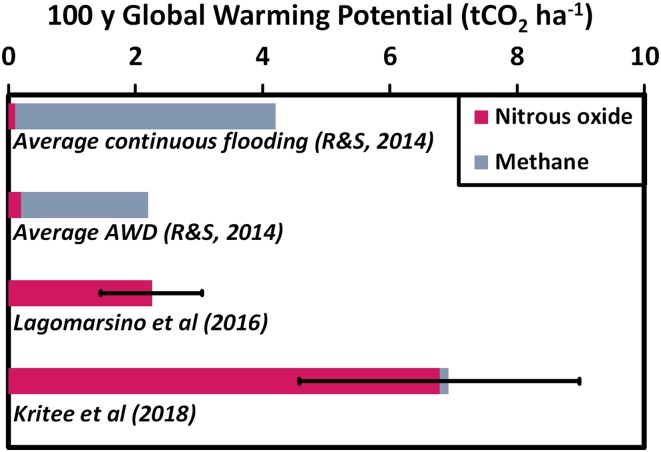Our fundamental message (1) is that under intense forms of intermittent flooding—a technique used to reduce methane emissions from rice farms (2)—emissions of nitrous oxide (N2O), a long-term climate forcer (Fig. 1), can be very high.
Fig. 1.
General understanding of climate impacts of rice farms under continuous flooding or alternate wetting and drying (AWD) (10) compared with our highest rice-N2O from two studies (1, 7) to highlight that N2O, not methane, is the dominant greenhouse gas emitted under intense forms of intermittent flooding.
In response to Yan and Akiyama (2), we stand by our statement (1) that “none of the major rice-producing countries…officially report rice-N2O or related emission factors” [(EFs); percentage of added fertilizer-N converted to nitrous oxide (N2O)]. Although China, India, and Indonesia (3–5) mention that rice farms can produce N2O and/or refer vaguely to using country-specific EFs, they do not provide EFs for rice or clarify what fraction of soil N2O, if any, came from rice. If these countries have used an average rice-N2O EF of 0.3% from the Intergovernmental Panel on Climate Change guidelines (6), it is a hundred times smaller than our highest EF (31%). This just reinforces our assessment that the potential of high rice-N2O should be a consideration in these inventories.
We are consistent in comparing the highest rice-N2O flux from among replicates reported by Lagomarsino et al. (7) with the highest flux from among our replicates. Our highest average rice-N2O flux (22.7 kg N2O·ha−1·season−1, Farm 3 2012) would still be approximately three times the previous highest (7.7 kg N2O·ha−1·season−1) (7).
Yan and Akiyama (2) question both the extent of mitigation possible through water management and our assertion that nitrogen management is not central to reducing rice-N2O. While N availability is necessary for N2O production, the N use rate was not central to rice-N2O, which was very low at two farms where the added N rate was very high (Farms 2 and 4). When farms are flooded and soil-oxygen content is low, either denitrification is limited by availability of oxidized N due to reduced nitrification or N2O converts into N2 (last denitrification step) (8). We do not claim that 90% mitigation can be achieved everywhere, but rather that this was the maximum mitigation observed in our study. We have already pointed out that more research is needed to minimize climate impacts per unit yield (see also SI appendix, figure S38 in ref. 1). Our global risk and mitigation analysis (9) suggests that up to 60% of the net climate impact of irrigated rice farms could be mitigated through water management without changing inorganic or organic fertilizer rates.
One study can determine neither the average business-as-usual climate impacts of rice cultivation nor the average mitigation potential of any farming technique(s). Our insight is that rice-N2O is a potentially large problem that needs due attention and can be managed. We invite mapping of flooding regimes at farmer-managed farms (as opposed to research-station plots that have consistent access to water/electricity) and more studies with over 50% sampling intensity at a range of intermittently flooded farms (Fig. 2).
Fig. 2.
Examples of flooding regimes.
Footnotes
The authors declare no conflict of interest.
References
- 1.Kritee K, et al. High nitrous oxide fluxes from rice indicate the need to manage water for both long- and short-term climate impacts. Proc Natl Acad Sci USA. 2018;115:9720–9725. doi: 10.1073/pnas.1809276115. [DOI] [PMC free article] [PubMed] [Google Scholar]
- 2.Yan X, Akiyama H. Overestimation of N2O mitigation potential by water management in rice paddy fields. Proc Natl Acad Sci USA. 2018;115:E11204–E11205. doi: 10.1073/pnas.1816208115. [DOI] [PMC free article] [PubMed] [Google Scholar]
- 3.Ministry of Environment, Forest and Climate Change . Government of India’s Second National Communication to the United Nations Framework Convention on Climate Change. Ministry of Environment, Forest and Climate Change; New Delhi: 2012. [Google Scholar]
- 4.Ministry of Environment and Forestry . Third National Communication of Indonesia to the United Nations Framework Convention on Climate Change ed Ministry of Environment and Forestry. Ministry of Environment and Forestry; Jakarta, Indonesia: 2018. [Google Scholar]
- 5.National Development and Reform Commission . Second National Communication on Climate Change of The People’s Republic of China. National Development and Reform Commission; Beijing: 2012. [Google Scholar]
- 6.de Klein C, et al. 2006. N2O emissions from managed soils, and CO2 emissions from lime and urea application. 2006 IPCC Guidelines for National Greenhouse Gas Inventories (Institute for Global Environmental Strategies, Hayama, Japan), Chap 11.
- 7.Lagomarsino A, et al. Alternate wetting and drying of rice reduced CH4 but triggered N2O peaks in a clayey soil of central Italy. Pedosphere. 2016;26:533–548. [Google Scholar]
- 8.Stein LY, Klotz MG. The nitrogen cycle. Curr Biol. 2016;26:R94–R98. doi: 10.1016/j.cub.2015.12.021. [DOI] [PubMed] [Google Scholar]
- 9.Kritee K, et al. 2018 Global risk assessment of high nitrous oxide emissions from rice production. Available at https://www.edf.org/sites/default/files/documents/EDF_White_Paper_Global_Risk_Analysis.pdf. Accessed November 6, 2018.
- 10.Richards M, Sander BO. Alternate Wetting and Drying in Irrigated Rice: Implementation Guide for Policymakers and Investors as Practice Brief on Climate Smart Agriculture. CGIAR Research Program on Climate Change, Agriculture and Food Security; Copenhagen: 2014. [Google Scholar]




